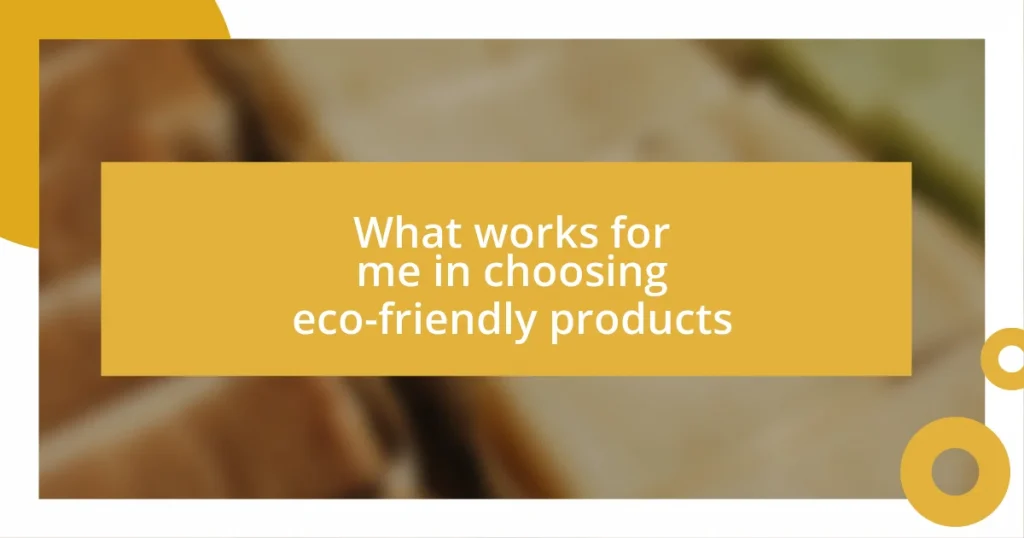Key takeaways:
- A green home prioritizes sustainable practices and materials that enhance well-being while conserving energy and resources.
- Implementing water conservation strategies and reducing waste through practices like composting and using reusable bags significantly benefit the environment.
- Educating others about sustainability through workshops and community initiatives fosters collective action and inspires more people to adopt eco-friendly habits.

Understanding a green home
Understanding a green home goes beyond just energy efficiency; it’s about creating a space that nurtures our well-being and respects the planet. I’ve often sat in my living room, surrounded by house plants and natural light, reflecting on how these elements not only purify the air but also enhance my mood. Have you ever noticed how a simple touch of greenery can change the entire atmosphere of a room?
A green home incorporates sustainable materials and practices, from the type of insulation used to the source of the furniture in our spaces. When I renovated my kitchen, I chose reclaimed wood for the cabinets, not just because it’s eco-friendly, but also because it tells a story—it carries a history. Isn’t it amazing how every choice can contribute to both your health and the planet’s future?
Moreover, a green home champions energy conservation, often resulting in lower utility bills. I remember the first time I switched to LED lighting; I was surprised to see a noticeable decrease in my electric bill the following month. Seeing those numbers drop sparked a sense of accomplishment in me, making sustainability feel both rewarding and achievable. It’s not just a trend; it’s a lifestyle that makes a real difference.

Choosing eco-friendly materials
Choosing eco-friendly materials is more than just a trend; it’s a commitment to our health and the environment. When I opted for bamboo flooring in my home, I was pleasantly surprised by its beauty and durability. Each step on that floor reminds me of how sustainable choices can create spaces that feel both warm and responsible. It’s rewarding to know that by choosing a rapidly renewable resource like bamboo, I’m helping reduce deforestation.
When selecting eco-friendly materials, consider the following points:
- Look for certifications like FSC (Forest Stewardship Council) to ensure the wood products are responsibly sourced.
- Opt for low-VOC (volatile organic compounds) paints and finishes to improve indoor air quality.
- Choose recycled or upcycled materials that minimize waste and reduce the need for new resources.
- Consider natural fibers for textiles, such as organic cotton or linen, which are biodegradable and often produced without harmful chemicals.
These choices not only promote sustainability but also create a home that feels good to inhabit. I made my curtains from organic cotton, and every time I draw them open to let the morning light in, I’m reminded of my intention to live in harmony with nature. Isn’t it uplifting to think that every little decision contributes to a larger purpose?

Implementing energy saving practices
Implementing energy-saving practices in my home has transformed how I view daily routines. I’ve installed programmable thermostats that help manage my heating and cooling efficiently. It feels almost magical when I walk into my home and the temperature is just right, all because I set it in advance to adapt to my schedule. Have you ever thought about how much energy gets wasted on heating or cooling spaces when no one is home?
Another impactful change I made was to unplug devices when they’re not in use. I was shocked to learn about phantom energy—wasted energy by electronics in standby mode. Now, I keep a power strip in accessible places to easily cut off power to multiple devices at once. It’s those small actions that build up over time, much like putting away loose change. Do you remember the satisfaction of counting how much you saved? Each unplugged device feels like adding to my energy-saving jar.
Lastly, I’ve invested in energy-efficient appliances that not only save power but also make my life easier. My dishwasher came with an eco-mode that’s surprisingly effective. It continually amazes me how much cleaner my dishes come out while using less water and energy. I still recall that moment of astonishment when I decided to look closely at the energy ratings—switching from an older model to this one felt like I was giving my kitchen a valuable upgrade. Implementing energy-saving practices isn’t just about responsibility; it’s also about enhancing everyday living.
| Practice | Impact |
|---|---|
| Programmable Thermostats | Optimizes heating/cooling, saves energy |
| Unplugging Devices | Reduces phantom energy waste |
| Energy-Efficient Appliances | Less energy/water usage, improved performance |

Water conservation strategies
Water conservation is something I’ve become increasingly passionate about. One of my favorite strategies is rainwater harvesting. I installed a rain barrel in my backyard, and it feels great to use that water for my garden. Each time I see my plants thrive with this natural resource, I am reminded of how powerful nature can be. Have you ever considered how much rainwater goes to waste?
Another simple yet effective way I conserve water is by installing low-flow showerheads and faucet aerators. These devices can cut water usage significantly without sacrificing pressure. When I first switched, I was skeptical about whether I’d even notice a difference. But to my surprise, my showers still feel refreshing while using much less water. It’s amazing how small changes can lead to significant savings.
Lastly, I’ve made it a routine to collect water that runs from the tap while waiting for it to warm up, using it to water my indoor plants or fill pet bowls. This habit not only minimizes waste but also connects me to my home and its needs. Every time I pour that saved water into a plant, I feel a sense of accomplishment, as if I’m nurturing life itself. What if we all made that small effort to repurpose water? Think of the impact we could have collectively!

Reducing waste in daily life
Reducing waste in my daily life has been a transformative journey, and it starts with my shopping habits. I now bring my own reusable bags to the grocery store, and it’s sort of satisfying to see the cashier load my fresh produce, knowing I’m making a small yet meaningful impact. When was the last time you thought about how many plastic bags you encounter on a single shopping trip?
Something that genuinely shocked me was how much food gets wasted in a home. Inspired to change that, I now plan my meals every week and make a shopping list based on what I already have. Each time I transform those ripe bananas into a delicious smoothie, I feel like I’ve turned potential waste into something delightful. Have you ever realized just how creative you can get with leftovers?
Additionally, I’ve embraced the art of composting, and it’s been surprisingly rewarding. Having a small compost bin on my kitchen counter is like cultivating a mini-ecosystem. I remember my first batch of compost—it felt like pure gold when I used it in my garden. While it might seem daunting at first, I can assure you that the effort pays off. What if everyone took the time to compost? Just imagine the waste reduction we could achieve together!

Creating a sustainable garden
Creating a sustainable garden is one of my favorite ways to connect with nature while being eco-conscious. I decided to embrace native plants, which thrive in my local climate without needing excessive water or fertilizers. It’s truly gratifying to watch these plants flourish, knowing they’re not just beautiful, but also beneficial for local wildlife. Have you ever noticed how diverse your local flora can be?
I also practice companion planting in my garden. By strategically placing certain plants together, like tomatoes and basil, I’ve been able to naturally repel pests and boost growth. The first summer I tried this, I was amazed at how much healthier my plants looked compared to past seasons. It feels like I’m creating a tiny ecosystem that works in harmony with itself. Have you explored how plants can support each other in your garden?
Last year, I started incorporating organic mulch around my plants, which has been a game changer. Not only does it help retain moisture, but it also suppresses weeds effortlessly. When I spread that first layer of mulch, I felt a sense of satisfaction, knowing that I was both protecting my plants and improving the soil health. Have you considered what simple practices like this could do for your garden? It’s like giving your plants a nurturing hug!

Educating others about sustainability
Educating others about sustainability is something I’m incredibly passionate about. I often host small workshops in my community, where I share practical tips on reducing waste and making eco-friendly choices. The first time I saw someone in the audience light up when they realized they could make a difference felt like magic. Isn’t it invigorating to see that spark of understanding in others?
When I talk about sustainability, I always emphasize that it’s about small, achievable changes rather than overwhelming transformations. For example, I started a friendly neighborhood challenge to bring our own containers to local eateries. Watching my neighbors embrace this practice made me realize how contagious enthusiasm can be. Have you ever felt the power of collective action in bringing about change?
I find social media can be a powerful tool for spreading awareness too. I often share my personal experiences on platforms, like how I switched to eco-friendly products and the journey of my sustainable garden. The stories and struggles resonate with others, and I get countless messages from people wanting to start their own path to sustainability. Doesn’t it feel good to inspire others to take that first step?















